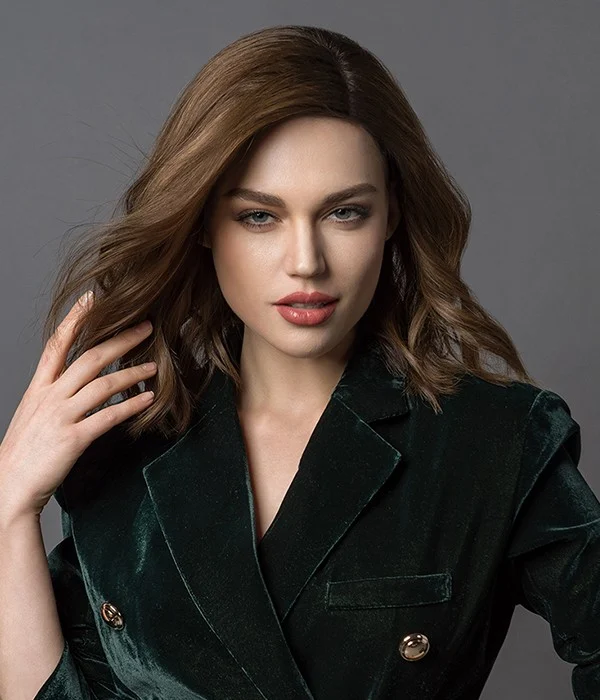Hair toppers are designed to look very natural and provide confidence and self-esteem for those facing hair loss challenges. Hair toppers are an essential hair accessory for individuals who experience hair loss or thinning. In 2021, the volume of products was 77,700 tons. There has been a rise of 21.6%. Welcome to our guide where we will discuss the advantages of using hair toppers, provide helpful tips on selecting the appropriate hair topper, and share some useful advice on maintaining your hair topper.
Understanding Hairpieces
Hair toppers are innovative hair accessories designed to address hair loss or thinning. They provide coverage and volume to specific scalp areas requiring extra support. They come in various shapes, sizes, and styles, ensuring seamless, integration with your natural hair.

The Benefits of Hairpieces for Women
- Natural Appearance: Hair toppers are meticulously designed to mimic real hair’s natural growth and movement. The use of high-quality materials ensures that the toppers appear lifelike and blend seamlessly with natural hair.
- Instant Volume and Coverage: Hairpieces offer an immediate solution for adding volume and coverage to thinning areas or bald patches. Whether your hair loss is due to aging, genetics, or medical conditions, they provide the desired coverage, allowing you to achieve the hairstyle you desire.
- Versatile Styling Options: Offer endless possibilities for styling. You can cut, color, and style them just like your natural hair, allowing for seamless integration with your existing hairstyle. Whether you prefer sleek and straight or voluminous curls, the choice is yours. Embrace your creativity and experiment with different looks effortlessly.
- ConfidenceBoost: Hair loss can significantly impact a woman’s self-confidence. By restoring a fuller and more voluminous hairstyle, they provide a confidence boost, helping you feel beautiful and empowered.
Types of Wiglets
Synthetic Hair
a) Synthetic Fiber – No heat can be applied

Synthetic hair is artificial fiber. Not all synthetic fibers are equal in quality. Lower-quality synthetic fibers are shinier in appearance and are less realistic in texture and movement.
Generally, synthetic fiber cannot be straightened or curled with heat tools. Heat cannot be applied to any of these low-temperature synthetic fibers, so they cannot be curled or straightened by a hot tool
b) SyntheticFiber – Heat-friendly
Synthetic fiber cannot be exposed to high temperatures unless the synthetic topper is “heat -resistant”. Toppers made with heat-friendly or heat-resistant synthetic fiber, such as Futura, Tru2Life and Real Tress Fiber can be styled using a low to medium heat setting. High-temperature heat-friendly synthetic fiber can withstand heat up to350°F/180°C.
Human Hair
There are four main types of human hair that are often used to make hair toppers. These are Indian, Chinese, Brazilian, and European. We will only talk about remy human hair here for a fair comparison.

a) Indian RemyHair
Indian human hair is soft and fine. Indian hair has a similar genetic structure to European hair, but Indian hair has more compact cuticle cells (thicker) than that of Caucasians. Indian remy human hair comes in different hair texture options: naturally straight/wavy/curly and Indian hair is available in shades of black and dark brown.
b) Chinese Remy Hair
Chinese hair is known for its sleekness, manageability, and strength. Chinese remy human hair has become one of the most popular hair types on the market of alternative hair. The reasons are clear: customers want healthy, strong hair that is sleek and tangle free. Chinese hair is usually available in naturally straight and in shades of black and darkest brown.
- c) Brazilian Remy hair
Brazilian human hair is one of the most practical human hair types on the market. It is typically soft and relatively thick compared to European and Indian Hair.
- d) European Hair
When it comes to European Hair, people usually associate it with some keywords: expensive, luxury, soft, and fine hair texture. European hair has its advantages, but it also has its limitations.
Choosing the Right Hair Topper
- Assess Your Needs: Start by identifying the specific areas of your scalp that require coverage. Determine whether you need a full topper to cover the entire head or a partial topper to address specific areas of hair loss or thinning. Consider your desired hair volume, texture, and color to ensure a seamless blend with your natural hair.
- ChoosetheBase Material: They come with different base materials, including lace, monofilament, and silk. Lace provides a natural, breathable, and lightweight option, while monofilament offers durability and a realistic scalp appearance. Silk bases provide a smooth and comfortable fit. Consider your comfort, desired level of realism, and lifestyle when selecting the base material.
- Select the Attachment Method: They can be attached using clips, tapes, or bonding adhesives. Clips are convenient for easy attachment and removal, making them suitable for those who prefer versatility. Tapes offer a secure and semi-permanent attachment, while bonding adhesives provide a more long-term solution. Choose the attachment method that aligns with your preferences and lifestyle.
- FindtheRight Color and Style: Match the hair topper’s color and style to your natural hair for a seamless blend. You can choose the color rings and find the right color. Consider factors such as hair density, curl pattern, and shade. If you can’t find an exact match, opt for a topper that is slightly lighter or darker and has it customized by a professional stylist. Additionally, choose a style that complements your face shape and desired look, whether it’s straight, wavy, or curly.
How to Wear and Maintain Your Hair Topper
- 1. Application Techniques: Depending on the type of hair topper, you can attach it using clips, adhesive tapes, or wig grips. Experiment with different techniques to find the most secure and comfortable method for you.
- Washing: Use a gentle shampoo specifically designed for human hair wigs. Spray adhesive remover onto the lace edge and use a soft-bristle toothbrush to make circular motions. Avoid rubbing or twisting the hair and instead gently comb through it with a wide-toothed comb. Apply a conditioner and rinse thoroughly.
- 3. StylingTips: Style your topper before attaching it to your hair. Use heat styling tools on low to medium heat settings and apply heat protectant products to prevent damage. Avoid sleeping or swimming with your topper to maintain its shape and longevity.
- Storage: When not in use, store your wig on a wig stand or in a clean and dry place. Avoid exposing it to direct sunlight, excessive heat, or humid environments, as these can damage the hair fibers.

Hair toppers offer women a versatile and practical solution to address hair loss or thinning, providing instant volume, coverage, and a confidence boost. With their natural appearance, styling versatility, and proper maintenance, they can seamlessly blend with your natural hair, allowing you to enhance your style and embrace your true beauty. By following the tips outlined in this guide and selecting the right for your needs, you can confidently reclaim your style and boost your self-confidence.